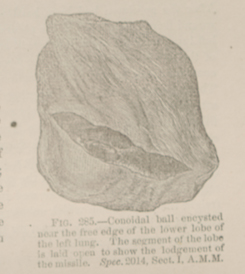Title: S——, W.
Source text: Surgeon General Joseph K. Barnes, United States Army, The Medical and Surgical History of the War of the Rebellion. (1861–65.), Part 1, Volume 2 (Washington, D.C.: Government Printing Office, 1870), 587.
Civil War Washington ID: med.d1e20302
TEI/XML: med.d1e20302.xml
CASE 15.—Corporal W. S——, Co. H, 151st New York Volunteers, aged 26 years, was admitted to the 3d division hospital, Alexandria, December 4th, 1863, with a gunshot penetrating wound of the left chest, received at Locust Grove, Virginia, November 27th. A conical ball entered two inches below the coracoid process, passed inward and downward and lodged in the posterior portion of the lower lobe of the left lung. When admitted, there was slight constitutional disturbance, diminished respiration of apex of left lung, slight cough, and white frothy expectorations. Sedatives, anodynes, and stimulants were administered, with nourishing diet. On the next day, the patient was able to walk about the ward and seemed quite comfortable. Nothing occurred to attract particular attention until January 3d, when the expectoration was noticed to be very offensive; respiration scarcely perceptible in the left lung; pulse very weak. January 8th, 1864, breathing labored, complete dulness of left side extending to right of sternum. He gradually sank, and died on January 10th, 1864. Necropsy: Left pleural cavity filled with serum; lung compressed in small space. Pericardium was much distended with fluid, amounting to twelve ounces, and the second rib comminuted. The ball had struck the sternum at the articulation of the second rib, which was denuded and rough. The whole surface of the pericardium was covered with coagulated lymph having the appearance of tripe. The ball was found in the posterior portion of the lower lobe of the right lung; the liver was enlarged and soft. A preparation of a portion of the left lung, with the missile lodged just beneath its surface, is represented in the wood-cut (FIG. 285). The lung has been laid open to display the lodgement of the ball. Even the rings on the base of the projectile are imprinted on the cheesy tissue. The specimen was contributed, with a history of the case, by Acting Assistant Surgeon W. G. Elliott.
